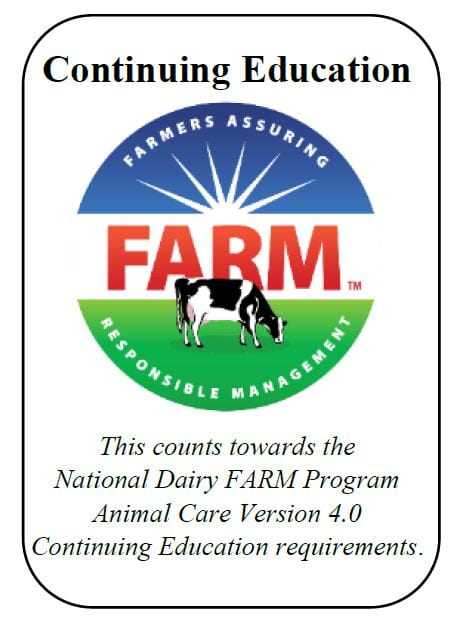As part of the National Dairy FARM Program Version 4.0, each dairy farm needs a non-ambulatory protocol and those involved in handling these animals need annual continuing education in this area. The objective of the non-ambulatory animal protocol and training is “to provide comfort and support to animals aiding in their recovery from injury/disease or to humanely euthanize animals that will not recover.”
As part of your protocol, you should be able to answer the following questions:
- How are employees trained to manage non-ambulatory animals?
- Who is responsible for decision making (ie: how to treat a down cow, when she should re-enter the herd, or when she should be euthanized)?
- What equipment is used to move non-ambulatory animals and how many employees should assist at one time?
- Where are non-ambulatory animals moved to, and does this location provide protection from the elements and predators and other animals in the herd, and is feed and water provided and accessible?
- What medical care is provided to these animals and when?
- Are treatments recorded and where?
- What other methods of rehabilitation are provided?
The first step to managing non-ambulatory animals is prevention. Ensure all employees handling animals receive stockmanship training (and annual continuing education) so animals are moved in a calm and low-stress manner. Facilities should provide adequate floor traction (ie: grooved and scraped clean), wide transfer alleys, and pens should be stocked to an appropriate level to allow animals enough room to move around safely.
Even with all the proper management and facility considerations, things can happen. Animals may become non-ambulatory and need special care, and it’s the farm’s responsibility to prepare for the worst and be able to respond quickly and appropriately. During a Dairy Cattle Welfare Council webinar last summer, Dr. Conrad Spangler from Riverview LLP, outlined his three key considerations when creating a farm’s “down cow team” including: “select the right people, give them the right training, and measure the right things”. Each facility needs to identify key people that are trained in how to respond to a non-ambulatory animal, and every employee needs to know who these people are to ensure the animal received prompt attention.
When an animal goes down, the trained personnel should be notified immediately. They should assess the situation and determine the potential prognosis and if moving the animal is the best option. The animal should only be moved using an approved method such as an appropriate sling, sled, or bucket, and not pulled or dragged. The animal should be placed in a hospital or sick pen that is separate from other animals in the herd. This pen should provide enough space, a lot of bedding and good traction, protection from the elements, adequate ventilation, and water and feed should be accessible to an animal that cannot rise. Here the animal should receive any further medical attention required and be checked on regularly to assess the status of recovery or if other treatments or actions are needed. Finally, each incident involving a non-ambulatory animal should be recorded, and include information on the cause, location, how it was handled, and the outcome. This will help identify any trends or indicate areas where more training may be needed.
If a non-ambulatory animal is unable to recover, euthanasia is most likely the only option. On-farm euthanasia practices must adhere to AABP/AVMA guidelines, and should include consultation from your herd veterinarian, and follow your euthanasia protocol (as required by the National Dairy FARM Program). Next month’s article will highlight what is needed for your euthanasia protocol on-farm.
The National Dairy FARM Program website includes a lot of resources including a template for a non-ambulatory protocol as well as a poster highlighting the proper care of these animals (https://nationaldairyfarm.com/wp-content/uploads/2018/10/DownCowPoster-Final.pdf). For more information or questions, please reach out to Regional Dairy Specialist Lindsay Ferlito (607-592-0290, lc636@cornell.edu).

